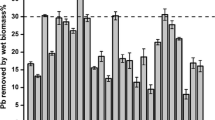Abstract
Recombinant Saccharomyces cerevisiae expressing human hepatic metallothionein (SC-mt) was constructed for biosorption of lead(II). The gene sequence of mt was modified for codon preference of S. cerevisiae (SC) and synthesized using a chemical method. The influences of different experimental parameters such as solution pH, initial concentration, contact time, and temperature on adsorption were investigated. SC and SC-mt showed the highest Pb(II) sorption capacity at initial pH of 5.0 and contact time of 30 min. Adsorption on SC-mt was more favorable than on SC; in addition, the saturated monolayer sorption capacity increased from 80.00 to 181.82 mg/g at 298 K. Adsorption kinetics was better described by a pseudo-second-order model, and the adsorption process could be well described by the Langmuir isotherm. Thermodynamic parameters of SC-mt, namely ΔG°(298 K), ΔH°, and ΔS°, were determined to be −17.91 and 12.13 kJ mol−1, and 100.81 J mol−1 K−1, respectively, demonstrating that the sorption process of SC-mt towards Pb(II) was feasible, spontaneous, and endothermic in nature. The results indicate that the recombinant S. cerevisiae SC-mt should be useful for enhancement of the effectiveness of lead biosorption in practice.
Graphical Abstract











Similar content being viewed by others
References
Das N, Vimala R, Karthika P (2008) India J Biotechnol 71:59
Park D, Yun YS, Park JM (2010) Biotechnol Bioproc E 15:86
Wang J, Chen C (2009) Biotechnol Adv 27:195
Lin Z, Ye Y, Li Q, Xu Z, Wang M (2011) BMC Biotechnol 11:98
Blériot C, Effantin G, Lagarde F, Mandrand-Berthelot MA, Rodrigue A (2011) J Bacteriol 193:3785
Malik A (2004) Environ Int 30:261
Gadd GM (2010) Microbiology 156:609
Chen XC, Wang YP, Lin Q, Shi JY, Wu WX, Chen YX (2005) Colloids Surf B Biointerfaces 46:101
Ghorbani S, Tabandeh F, Yakhchali B, Mehrnia MR (2011) Biotechnol Bioproc E 16:1019
Kiyono M, Pan-Hou H (2006) J Health Sci 52:199
Chen JP, Lin YS (2007) J Chin Inst Chem Eng, 38:235
Su YJ, Lin JQ, Hao DH (2009) Biotechnol Bioproc E 14:565
Wang J, Chen C (2006) Biotechnol Adv 24:427
Zhang Y, Fan C, Meng Q, Diao Z, Dong L, Peng X, Ma S, Zhou Q (2009) Bull Environ Contam Toxicol 83:708
Peng Q, Liu Y, Zeng G, Xu W, Yang C, Zhang J (2010) J Hazard Mater 177:676
Wu Y, Wen Y, Zhou J, Dai Q, Wu Y (2012) Environ Sci Pollut Res 19:3371
Dhankhar R, Hooda A, Solanki R, Sainger PA (2011) Int J Eng Sci Technol 3:5397
Kumar Y, King P, Prasad V (2006) Chem Eng J 124:63
Pimentel PM, González G, Melo MFA, Melo DMA, Silvajr C, Assunção ALC (2007) Sep Purif Technol 56:348
Anirudhan TS, Rijith S, Tharun AR (2010) Colloids Surf A 368:13
Donat RJ (2009) Chem Thermodyn 41:829
Acknowledgments
We are grateful to the National Science Foundation of China (Grant No. 21107014 and 21201033), Youth Science Foundation of Education Department of Jiangxi Province (Grant No. GJJ11140), National Science Foundation of China (Grant No. 21267001), and Fundamental Science on Radioactive Geology and Exploration Technology Laboratory Foundation (Grant No. REGT1217) for financial support.
Author information
Authors and Affiliations
Corresponding author
Additional information
J. Shang has equally contributed to this article.
Rights and permissions
About this article
Cite this article
Li, M., Zhang, Z., Shang, J. et al. Enhanced Pb2+ biosorption by recombinant Saccharomyces cerevisiae expressing human metallothionein. Monatsh Chem 145, 235–240 (2014). https://doi.org/10.1007/s00706-013-1016-5
Received:
Accepted:
Published:
Issue Date:
DOI: https://doi.org/10.1007/s00706-013-1016-5




